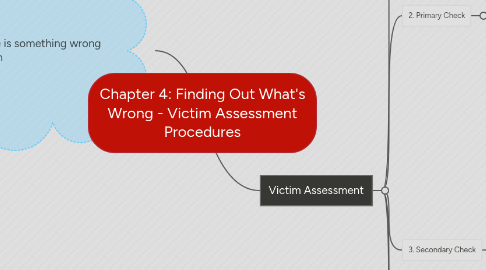
1. Knowing there is something wrong with the victim
1.1. Response or Unresponsive
1.2. Injured or Ill
1.3. Life threatening conditions exist
1.4. COI is significant or not
2. Victim Assessment
2.1. 1. Scene Size-Up
2.1.1. Always check: Safety at scene, nature or cause of injury, & number of victims
2.1.1.1. Potential dangers include: Broken glass, fire, angry bystanders, sharp objects.
2.2. 2. Primary Check
2.2.1. Identify life threatening conditions
2.2.1.1. Responsiveness (AVPU Scale): Alert &Responsive to Verbal Stimulus - Responsive to Painful Stimulus - Unresponsive to Any Stimulus
2.2.1.2. Circulation (Health Care Providers Only)
2.2.1.3. Check for breathing: 1. Open airway 2. Look for rise & fall of chest 3. Listen for normal or abnormal breath sounds 4. Feel for air movement
2.2.1.4. Severe bleeding: Look over the victim's body for blood soaked clothing or a pool of blood so that you can control the external bleeding before the victims bleeds to death
2.3. 3. Secondary Check
2.3.1. Identify potentially life threatening conditions
2.3.1.1. Head-to-toe physical exam (no more than 2 minutes)
2.3.1.2. Look & feel for (DOTS): Deformities - Open Wounds - Tenderness - Swelling
2.3.1.3. Assess the victim for spinal injury
2.4. 4. SAMPLE History
2.4.1. Check the the victim for S=Symptoms, A=Allergies, M=Medications, P=Past medical history, L=Last oral intake, E=Events leading up to illness or injury
2.5. 5. Reassessment
2.5.1. Regularly recheck the victim until EMS arrives
2.5.1.1. Every 15 minutes if victim is alert or responsive
2.5.1.2. Every 5 minutes if victim is unresponsive
